AN5006: Case Studies on Women-Centered Initiatives in Japan
VerifiedAdded on 2023/04/20
|14
|4244
|86
Essay
AI Summary
This essay examines the shortcomings of women-centered development initiatives in Japan, highlighting the persistent gender inequality despite the country's economic advancement. Through two case studies, including sexual discrimination at Tokyo Medical University and sexual harassment incidents following a Japan-Colombia soccer match, the paper illustrates how societal norms and inadequate law enforcement contribute to the problem. The essay further discusses the challenges faced by transgender individuals in Japan due to rigid legal frameworks and cultural values. Despite government initiatives, significant gender gaps persist in health, education, economy, and politics, hindering Japan's overall progress. The analysis underscores the urgent need for comprehensive reforms and a shift in societal attitudes to achieve genuine gender equality and foster further prosperity in Japan. Desklib offers a variety of resources for students, including past papers and solved assignments.

Running head: AN5006 task 4
AN5006 task 4
Name of the student:
Name of the university:
Author name:
AN5006 task 4
Name of the student:
Name of the university:
Author name:
Paraphrase This Document
Need a fresh take? Get an instant paraphrase of this document with our AI Paraphraser
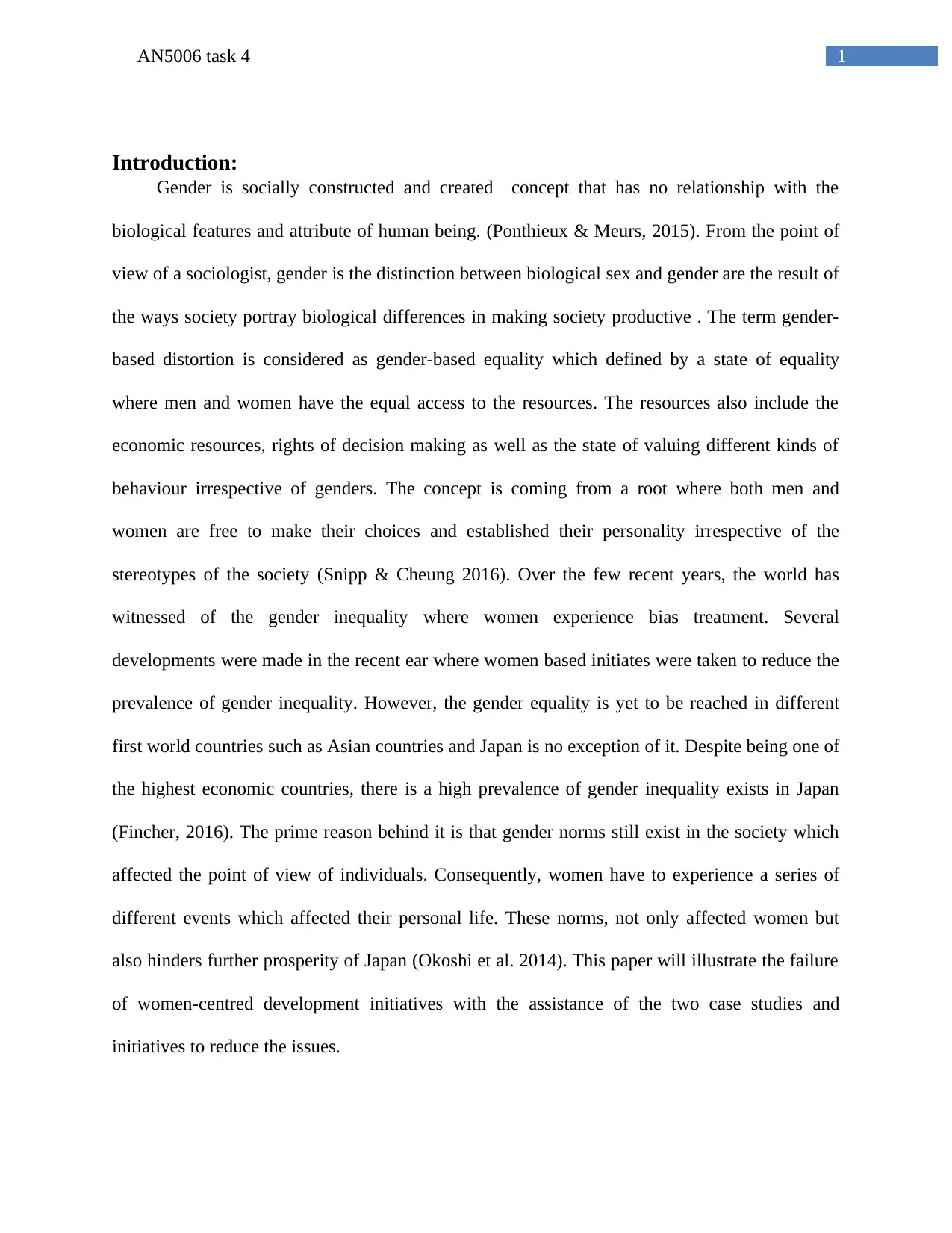
1AN5006 task 4
Introduction:
Gender is socially constructed and created concept that has no relationship with the
biological features and attribute of human being. (Ponthieux & Meurs, 2015). From the point of
view of a sociologist, gender is the distinction between biological sex and gender are the result of
the ways society portray biological differences in making society productive . The term gender-
based distortion is considered as gender-based equality which defined by a state of equality
where men and women have the equal access to the resources. The resources also include the
economic resources, rights of decision making as well as the state of valuing different kinds of
behaviour irrespective of genders. The concept is coming from a root where both men and
women are free to make their choices and established their personality irrespective of the
stereotypes of the society (Snipp & Cheung 2016). Over the few recent years, the world has
witnessed of the gender inequality where women experience bias treatment. Several
developments were made in the recent ear where women based initiates were taken to reduce the
prevalence of gender inequality. However, the gender equality is yet to be reached in different
first world countries such as Asian countries and Japan is no exception of it. Despite being one of
the highest economic countries, there is a high prevalence of gender inequality exists in Japan
(Fincher, 2016). The prime reason behind it is that gender norms still exist in the society which
affected the point of view of individuals. Consequently, women have to experience a series of
different events which affected their personal life. These norms, not only affected women but
also hinders further prosperity of Japan (Okoshi et al. 2014). This paper will illustrate the failure
of women-centred development initiatives with the assistance of the two case studies and
initiatives to reduce the issues.
Introduction:
Gender is socially constructed and created concept that has no relationship with the
biological features and attribute of human being. (Ponthieux & Meurs, 2015). From the point of
view of a sociologist, gender is the distinction between biological sex and gender are the result of
the ways society portray biological differences in making society productive . The term gender-
based distortion is considered as gender-based equality which defined by a state of equality
where men and women have the equal access to the resources. The resources also include the
economic resources, rights of decision making as well as the state of valuing different kinds of
behaviour irrespective of genders. The concept is coming from a root where both men and
women are free to make their choices and established their personality irrespective of the
stereotypes of the society (Snipp & Cheung 2016). Over the few recent years, the world has
witnessed of the gender inequality where women experience bias treatment. Several
developments were made in the recent ear where women based initiates were taken to reduce the
prevalence of gender inequality. However, the gender equality is yet to be reached in different
first world countries such as Asian countries and Japan is no exception of it. Despite being one of
the highest economic countries, there is a high prevalence of gender inequality exists in Japan
(Fincher, 2016). The prime reason behind it is that gender norms still exist in the society which
affected the point of view of individuals. Consequently, women have to experience a series of
different events which affected their personal life. These norms, not only affected women but
also hinders further prosperity of Japan (Okoshi et al. 2014). This paper will illustrate the failure
of women-centred development initiatives with the assistance of the two case studies and
initiatives to reduce the issues.
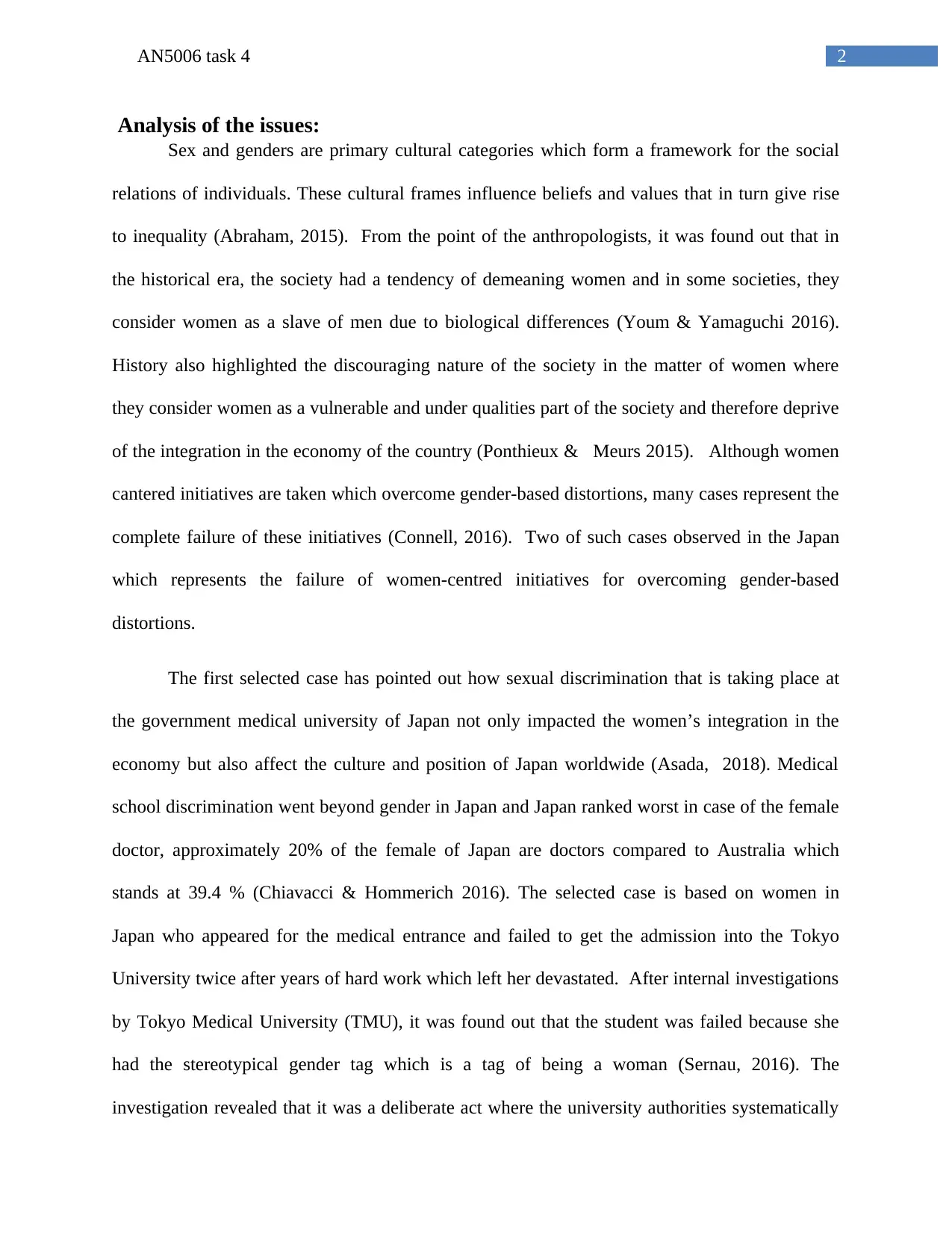
2AN5006 task 4
Analysis of the issues:
Sex and genders are primary cultural categories which form a framework for the social
relations of individuals. These cultural frames influence beliefs and values that in turn give rise
to inequality (Abraham, 2015). From the point of the anthropologists, it was found out that in
the historical era, the society had a tendency of demeaning women and in some societies, they
consider women as a slave of men due to biological differences (Youm & Yamaguchi 2016).
History also highlighted the discouraging nature of the society in the matter of women where
they consider women as a vulnerable and under qualities part of the society and therefore deprive
of the integration in the economy of the country (Ponthieux & Meurs 2015). Although women
cantered initiatives are taken which overcome gender-based distortions, many cases represent the
complete failure of these initiatives (Connell, 2016). Two of such cases observed in the Japan
which represents the failure of women-centred initiatives for overcoming gender-based
distortions.
The first selected case has pointed out how sexual discrimination that is taking place at
the government medical university of Japan not only impacted the women’s integration in the
economy but also affect the culture and position of Japan worldwide (Asada, 2018). Medical
school discrimination went beyond gender in Japan and Japan ranked worst in case of the female
doctor, approximately 20% of the female of Japan are doctors compared to Australia which
stands at 39.4 % (Chiavacci & Hommerich 2016). The selected case is based on women in
Japan who appeared for the medical entrance and failed to get the admission into the Tokyo
University twice after years of hard work which left her devastated. After internal investigations
by Tokyo Medical University (TMU), it was found out that the student was failed because she
had the stereotypical gender tag which is a tag of being a woman (Sernau, 2016). The
investigation revealed that it was a deliberate act where the university authorities systematically
Analysis of the issues:
Sex and genders are primary cultural categories which form a framework for the social
relations of individuals. These cultural frames influence beliefs and values that in turn give rise
to inequality (Abraham, 2015). From the point of the anthropologists, it was found out that in
the historical era, the society had a tendency of demeaning women and in some societies, they
consider women as a slave of men due to biological differences (Youm & Yamaguchi 2016).
History also highlighted the discouraging nature of the society in the matter of women where
they consider women as a vulnerable and under qualities part of the society and therefore deprive
of the integration in the economy of the country (Ponthieux & Meurs 2015). Although women
cantered initiatives are taken which overcome gender-based distortions, many cases represent the
complete failure of these initiatives (Connell, 2016). Two of such cases observed in the Japan
which represents the failure of women-centred initiatives for overcoming gender-based
distortions.
The first selected case has pointed out how sexual discrimination that is taking place at
the government medical university of Japan not only impacted the women’s integration in the
economy but also affect the culture and position of Japan worldwide (Asada, 2018). Medical
school discrimination went beyond gender in Japan and Japan ranked worst in case of the female
doctor, approximately 20% of the female of Japan are doctors compared to Australia which
stands at 39.4 % (Chiavacci & Hommerich 2016). The selected case is based on women in
Japan who appeared for the medical entrance and failed to get the admission into the Tokyo
University twice after years of hard work which left her devastated. After internal investigations
by Tokyo Medical University (TMU), it was found out that the student was failed because she
had the stereotypical gender tag which is a tag of being a woman (Sernau, 2016). The
investigation revealed that it was a deliberate act where the university authorities systematically
⊘ This is a preview!⊘
Do you want full access?
Subscribe today to unlock all pages.

Trusted by 1+ million students worldwide
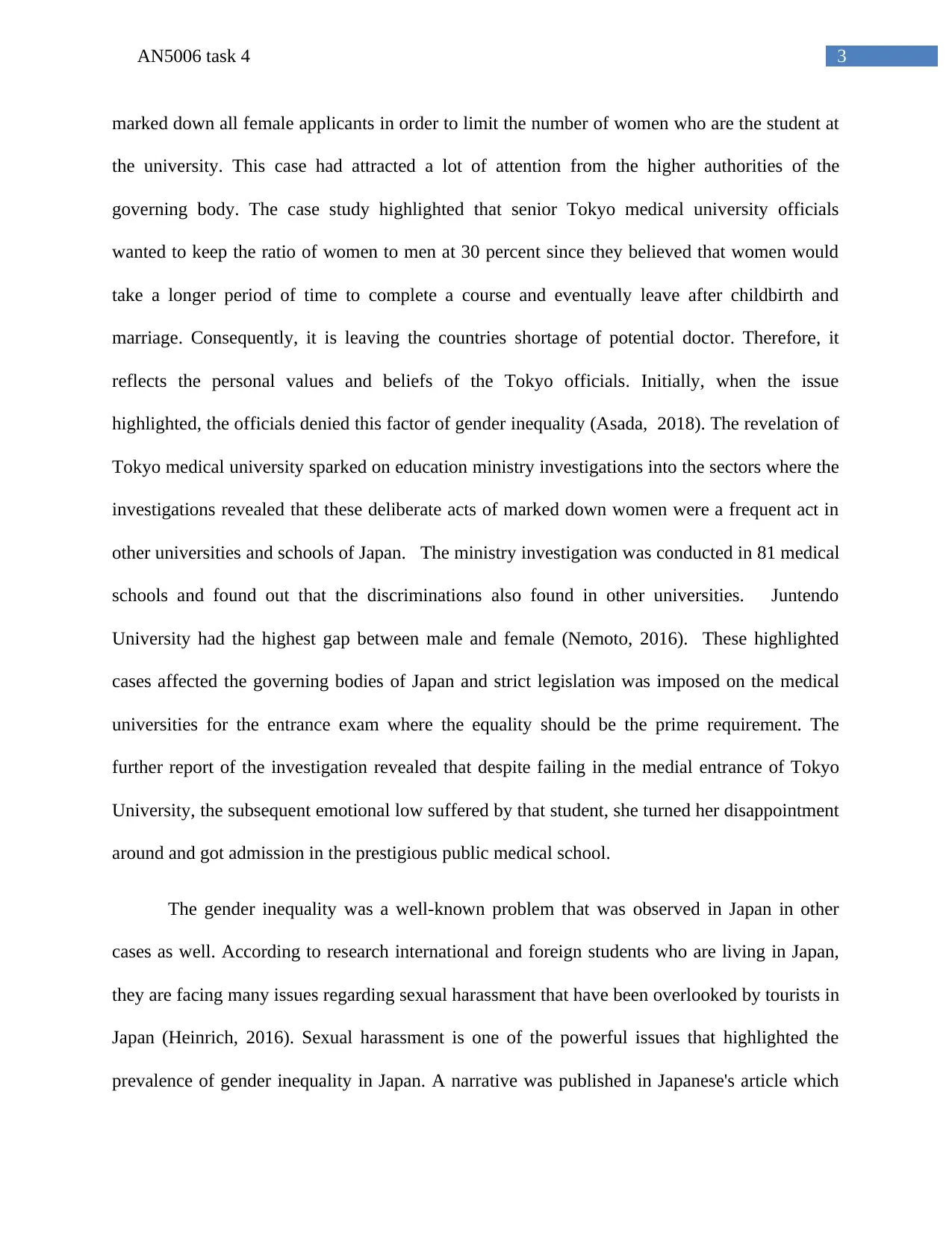
3AN5006 task 4
marked down all female applicants in order to limit the number of women who are the student at
the university. This case had attracted a lot of attention from the higher authorities of the
governing body. The case study highlighted that senior Tokyo medical university officials
wanted to keep the ratio of women to men at 30 percent since they believed that women would
take a longer period of time to complete a course and eventually leave after childbirth and
marriage. Consequently, it is leaving the countries shortage of potential doctor. Therefore, it
reflects the personal values and beliefs of the Tokyo officials. Initially, when the issue
highlighted, the officials denied this factor of gender inequality (Asada, 2018). The revelation of
Tokyo medical university sparked on education ministry investigations into the sectors where the
investigations revealed that these deliberate acts of marked down women were a frequent act in
other universities and schools of Japan. The ministry investigation was conducted in 81 medical
schools and found out that the discriminations also found in other universities. Juntendo
University had the highest gap between male and female (Nemoto, 2016). These highlighted
cases affected the governing bodies of Japan and strict legislation was imposed on the medical
universities for the entrance exam where the equality should be the prime requirement. The
further report of the investigation revealed that despite failing in the medial entrance of Tokyo
University, the subsequent emotional low suffered by that student, she turned her disappointment
around and got admission in the prestigious public medical school.
The gender inequality was a well-known problem that was observed in Japan in other
cases as well. According to research international and foreign students who are living in Japan,
they are facing many issues regarding sexual harassment that have been overlooked by tourists in
Japan (Heinrich, 2016). Sexual harassment is one of the powerful issues that highlighted the
prevalence of gender inequality in Japan. A narrative was published in Japanese's article which
marked down all female applicants in order to limit the number of women who are the student at
the university. This case had attracted a lot of attention from the higher authorities of the
governing body. The case study highlighted that senior Tokyo medical university officials
wanted to keep the ratio of women to men at 30 percent since they believed that women would
take a longer period of time to complete a course and eventually leave after childbirth and
marriage. Consequently, it is leaving the countries shortage of potential doctor. Therefore, it
reflects the personal values and beliefs of the Tokyo officials. Initially, when the issue
highlighted, the officials denied this factor of gender inequality (Asada, 2018). The revelation of
Tokyo medical university sparked on education ministry investigations into the sectors where the
investigations revealed that these deliberate acts of marked down women were a frequent act in
other universities and schools of Japan. The ministry investigation was conducted in 81 medical
schools and found out that the discriminations also found in other universities. Juntendo
University had the highest gap between male and female (Nemoto, 2016). These highlighted
cases affected the governing bodies of Japan and strict legislation was imposed on the medical
universities for the entrance exam where the equality should be the prime requirement. The
further report of the investigation revealed that despite failing in the medial entrance of Tokyo
University, the subsequent emotional low suffered by that student, she turned her disappointment
around and got admission in the prestigious public medical school.
The gender inequality was a well-known problem that was observed in Japan in other
cases as well. According to research international and foreign students who are living in Japan,
they are facing many issues regarding sexual harassment that have been overlooked by tourists in
Japan (Heinrich, 2016). Sexual harassment is one of the powerful issues that highlighted the
prevalence of gender inequality in Japan. A narrative was published in Japanese's article which
Paraphrase This Document
Need a fresh take? Get an instant paraphrase of this document with our AI Paraphraser
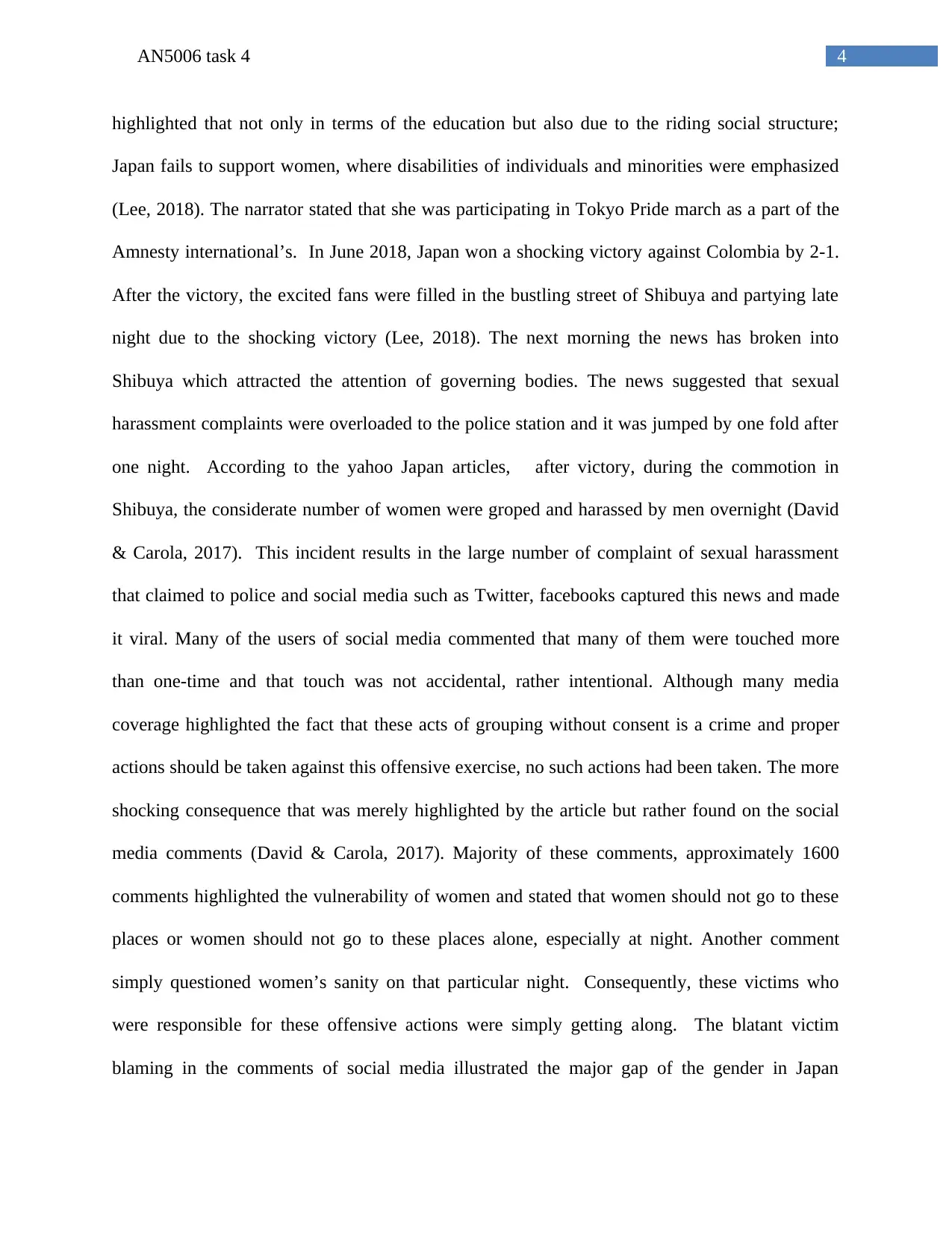
4AN5006 task 4
highlighted that not only in terms of the education but also due to the riding social structure;
Japan fails to support women, where disabilities of individuals and minorities were emphasized
(Lee, 2018). The narrator stated that she was participating in Tokyo Pride march as a part of the
Amnesty international’s. In June 2018, Japan won a shocking victory against Colombia by 2-1.
After the victory, the excited fans were filled in the bustling street of Shibuya and partying late
night due to the shocking victory (Lee, 2018). The next morning the news has broken into
Shibuya which attracted the attention of governing bodies. The news suggested that sexual
harassment complaints were overloaded to the police station and it was jumped by one fold after
one night. According to the yahoo Japan articles, after victory, during the commotion in
Shibuya, the considerate number of women were groped and harassed by men overnight (David
& Carola, 2017). This incident results in the large number of complaint of sexual harassment
that claimed to police and social media such as Twitter, facebooks captured this news and made
it viral. Many of the users of social media commented that many of them were touched more
than one-time and that touch was not accidental, rather intentional. Although many media
coverage highlighted the fact that these acts of grouping without consent is a crime and proper
actions should be taken against this offensive exercise, no such actions had been taken. The more
shocking consequence that was merely highlighted by the article but rather found on the social
media comments (David & Carola, 2017). Majority of these comments, approximately 1600
comments highlighted the vulnerability of women and stated that women should not go to these
places or women should not go to these places alone, especially at night. Another comment
simply questioned women’s sanity on that particular night. Consequently, these victims who
were responsible for these offensive actions were simply getting along. The blatant victim
blaming in the comments of social media illustrated the major gap of the gender in Japan
highlighted that not only in terms of the education but also due to the riding social structure;
Japan fails to support women, where disabilities of individuals and minorities were emphasized
(Lee, 2018). The narrator stated that she was participating in Tokyo Pride march as a part of the
Amnesty international’s. In June 2018, Japan won a shocking victory against Colombia by 2-1.
After the victory, the excited fans were filled in the bustling street of Shibuya and partying late
night due to the shocking victory (Lee, 2018). The next morning the news has broken into
Shibuya which attracted the attention of governing bodies. The news suggested that sexual
harassment complaints were overloaded to the police station and it was jumped by one fold after
one night. According to the yahoo Japan articles, after victory, during the commotion in
Shibuya, the considerate number of women were groped and harassed by men overnight (David
& Carola, 2017). This incident results in the large number of complaint of sexual harassment
that claimed to police and social media such as Twitter, facebooks captured this news and made
it viral. Many of the users of social media commented that many of them were touched more
than one-time and that touch was not accidental, rather intentional. Although many media
coverage highlighted the fact that these acts of grouping without consent is a crime and proper
actions should be taken against this offensive exercise, no such actions had been taken. The more
shocking consequence that was merely highlighted by the article but rather found on the social
media comments (David & Carola, 2017). Majority of these comments, approximately 1600
comments highlighted the vulnerability of women and stated that women should not go to these
places or women should not go to these places alone, especially at night. Another comment
simply questioned women’s sanity on that particular night. Consequently, these victims who
were responsible for these offensive actions were simply getting along. The blatant victim
blaming in the comments of social media illustrated the major gap of the gender in Japan
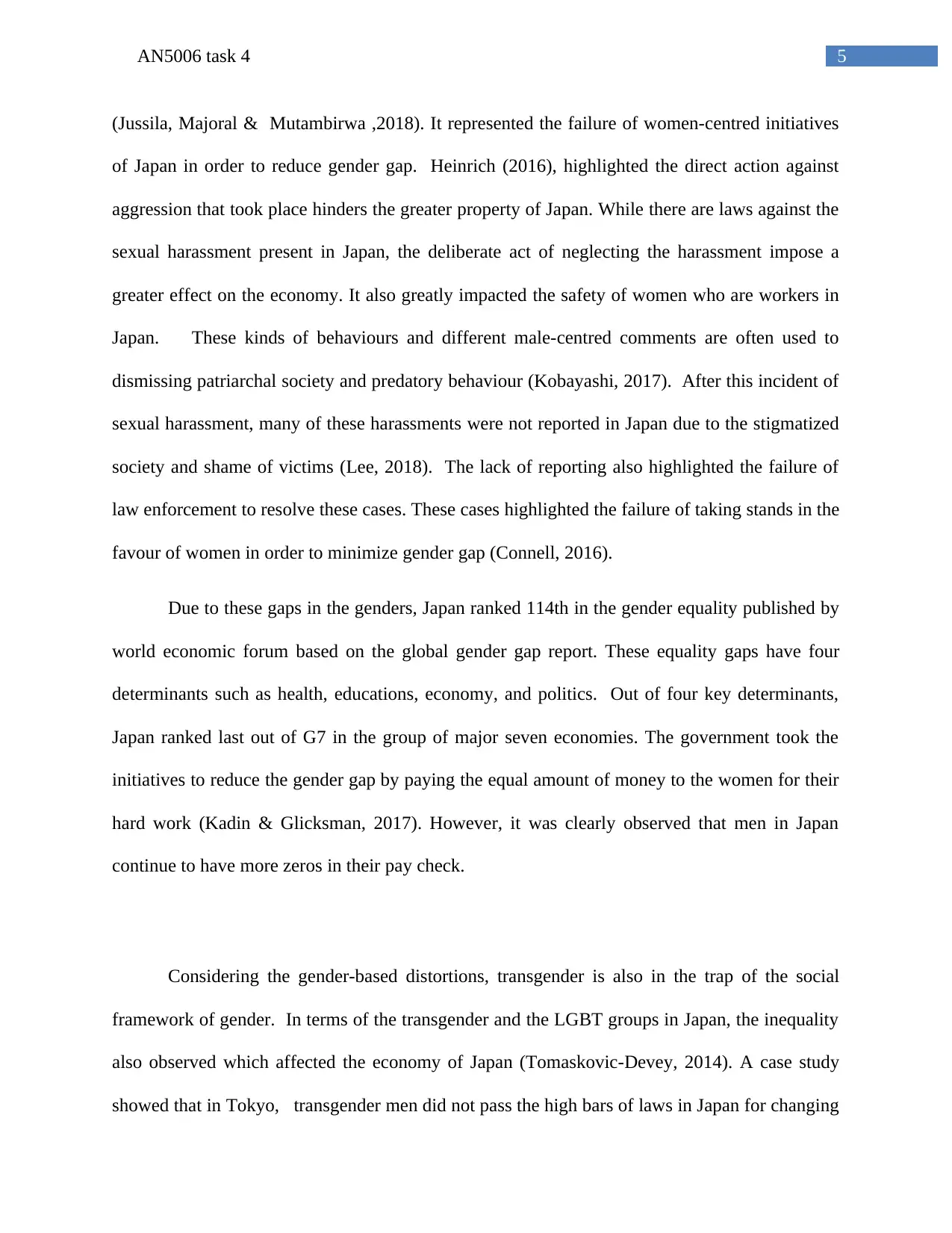
5AN5006 task 4
(Jussila, Majoral & Mutambirwa ,2018). It represented the failure of women-centred initiatives
of Japan in order to reduce gender gap. Heinrich (2016), highlighted the direct action against
aggression that took place hinders the greater property of Japan. While there are laws against the
sexual harassment present in Japan, the deliberate act of neglecting the harassment impose a
greater effect on the economy. It also greatly impacted the safety of women who are workers in
Japan. These kinds of behaviours and different male-centred comments are often used to
dismissing patriarchal society and predatory behaviour (Kobayashi, 2017). After this incident of
sexual harassment, many of these harassments were not reported in Japan due to the stigmatized
society and shame of victims (Lee, 2018). The lack of reporting also highlighted the failure of
law enforcement to resolve these cases. These cases highlighted the failure of taking stands in the
favour of women in order to minimize gender gap (Connell, 2016).
Due to these gaps in the genders, Japan ranked 114th in the gender equality published by
world economic forum based on the global gender gap report. These equality gaps have four
determinants such as health, educations, economy, and politics. Out of four key determinants,
Japan ranked last out of G7 in the group of major seven economies. The government took the
initiatives to reduce the gender gap by paying the equal amount of money to the women for their
hard work (Kadin & Glicksman, 2017). However, it was clearly observed that men in Japan
continue to have more zeros in their pay check.
Considering the gender-based distortions, transgender is also in the trap of the social
framework of gender. In terms of the transgender and the LGBT groups in Japan, the inequality
also observed which affected the economy of Japan (Tomaskovic-Devey, 2014). A case study
showed that in Tokyo, transgender men did not pass the high bars of laws in Japan for changing
(Jussila, Majoral & Mutambirwa ,2018). It represented the failure of women-centred initiatives
of Japan in order to reduce gender gap. Heinrich (2016), highlighted the direct action against
aggression that took place hinders the greater property of Japan. While there are laws against the
sexual harassment present in Japan, the deliberate act of neglecting the harassment impose a
greater effect on the economy. It also greatly impacted the safety of women who are workers in
Japan. These kinds of behaviours and different male-centred comments are often used to
dismissing patriarchal society and predatory behaviour (Kobayashi, 2017). After this incident of
sexual harassment, many of these harassments were not reported in Japan due to the stigmatized
society and shame of victims (Lee, 2018). The lack of reporting also highlighted the failure of
law enforcement to resolve these cases. These cases highlighted the failure of taking stands in the
favour of women in order to minimize gender gap (Connell, 2016).
Due to these gaps in the genders, Japan ranked 114th in the gender equality published by
world economic forum based on the global gender gap report. These equality gaps have four
determinants such as health, educations, economy, and politics. Out of four key determinants,
Japan ranked last out of G7 in the group of major seven economies. The government took the
initiatives to reduce the gender gap by paying the equal amount of money to the women for their
hard work (Kadin & Glicksman, 2017). However, it was clearly observed that men in Japan
continue to have more zeros in their pay check.
Considering the gender-based distortions, transgender is also in the trap of the social
framework of gender. In terms of the transgender and the LGBT groups in Japan, the inequality
also observed which affected the economy of Japan (Tomaskovic-Devey, 2014). A case study
showed that in Tokyo, transgender men did not pass the high bars of laws in Japan for changing
⊘ This is a preview!⊘
Do you want full access?
Subscribe today to unlock all pages.

Trusted by 1+ million students worldwide
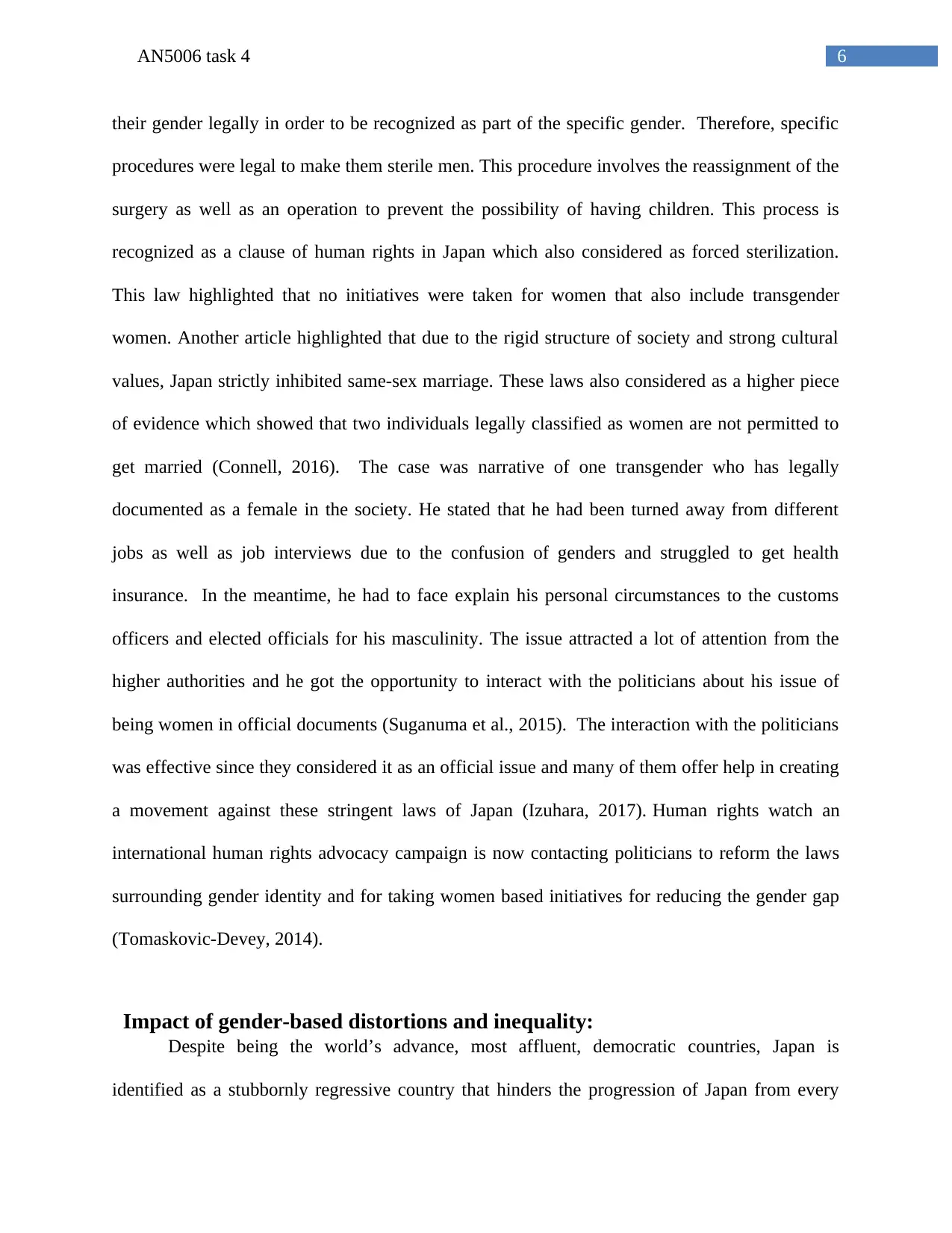
6AN5006 task 4
their gender legally in order to be recognized as part of the specific gender. Therefore, specific
procedures were legal to make them sterile men. This procedure involves the reassignment of the
surgery as well as an operation to prevent the possibility of having children. This process is
recognized as a clause of human rights in Japan which also considered as forced sterilization.
This law highlighted that no initiatives were taken for women that also include transgender
women. Another article highlighted that due to the rigid structure of society and strong cultural
values, Japan strictly inhibited same-sex marriage. These laws also considered as a higher piece
of evidence which showed that two individuals legally classified as women are not permitted to
get married (Connell, 2016). The case was narrative of one transgender who has legally
documented as a female in the society. He stated that he had been turned away from different
jobs as well as job interviews due to the confusion of genders and struggled to get health
insurance. In the meantime, he had to face explain his personal circumstances to the customs
officers and elected officials for his masculinity. The issue attracted a lot of attention from the
higher authorities and he got the opportunity to interact with the politicians about his issue of
being women in official documents (Suganuma et al., 2015). The interaction with the politicians
was effective since they considered it as an official issue and many of them offer help in creating
a movement against these stringent laws of Japan (Izuhara, 2017). Human rights watch an
international human rights advocacy campaign is now contacting politicians to reform the laws
surrounding gender identity and for taking women based initiatives for reducing the gender gap
(Tomaskovic-Devey, 2014).
Impact of gender-based distortions and inequality:
Despite being the world’s advance, most affluent, democratic countries, Japan is
identified as a stubbornly regressive country that hinders the progression of Japan from every
their gender legally in order to be recognized as part of the specific gender. Therefore, specific
procedures were legal to make them sterile men. This procedure involves the reassignment of the
surgery as well as an operation to prevent the possibility of having children. This process is
recognized as a clause of human rights in Japan which also considered as forced sterilization.
This law highlighted that no initiatives were taken for women that also include transgender
women. Another article highlighted that due to the rigid structure of society and strong cultural
values, Japan strictly inhibited same-sex marriage. These laws also considered as a higher piece
of evidence which showed that two individuals legally classified as women are not permitted to
get married (Connell, 2016). The case was narrative of one transgender who has legally
documented as a female in the society. He stated that he had been turned away from different
jobs as well as job interviews due to the confusion of genders and struggled to get health
insurance. In the meantime, he had to face explain his personal circumstances to the customs
officers and elected officials for his masculinity. The issue attracted a lot of attention from the
higher authorities and he got the opportunity to interact with the politicians about his issue of
being women in official documents (Suganuma et al., 2015). The interaction with the politicians
was effective since they considered it as an official issue and many of them offer help in creating
a movement against these stringent laws of Japan (Izuhara, 2017). Human rights watch an
international human rights advocacy campaign is now contacting politicians to reform the laws
surrounding gender identity and for taking women based initiatives for reducing the gender gap
(Tomaskovic-Devey, 2014).
Impact of gender-based distortions and inequality:
Despite being the world’s advance, most affluent, democratic countries, Japan is
identified as a stubbornly regressive country that hinders the progression of Japan from every
Paraphrase This Document
Need a fresh take? Get an instant paraphrase of this document with our AI Paraphraser
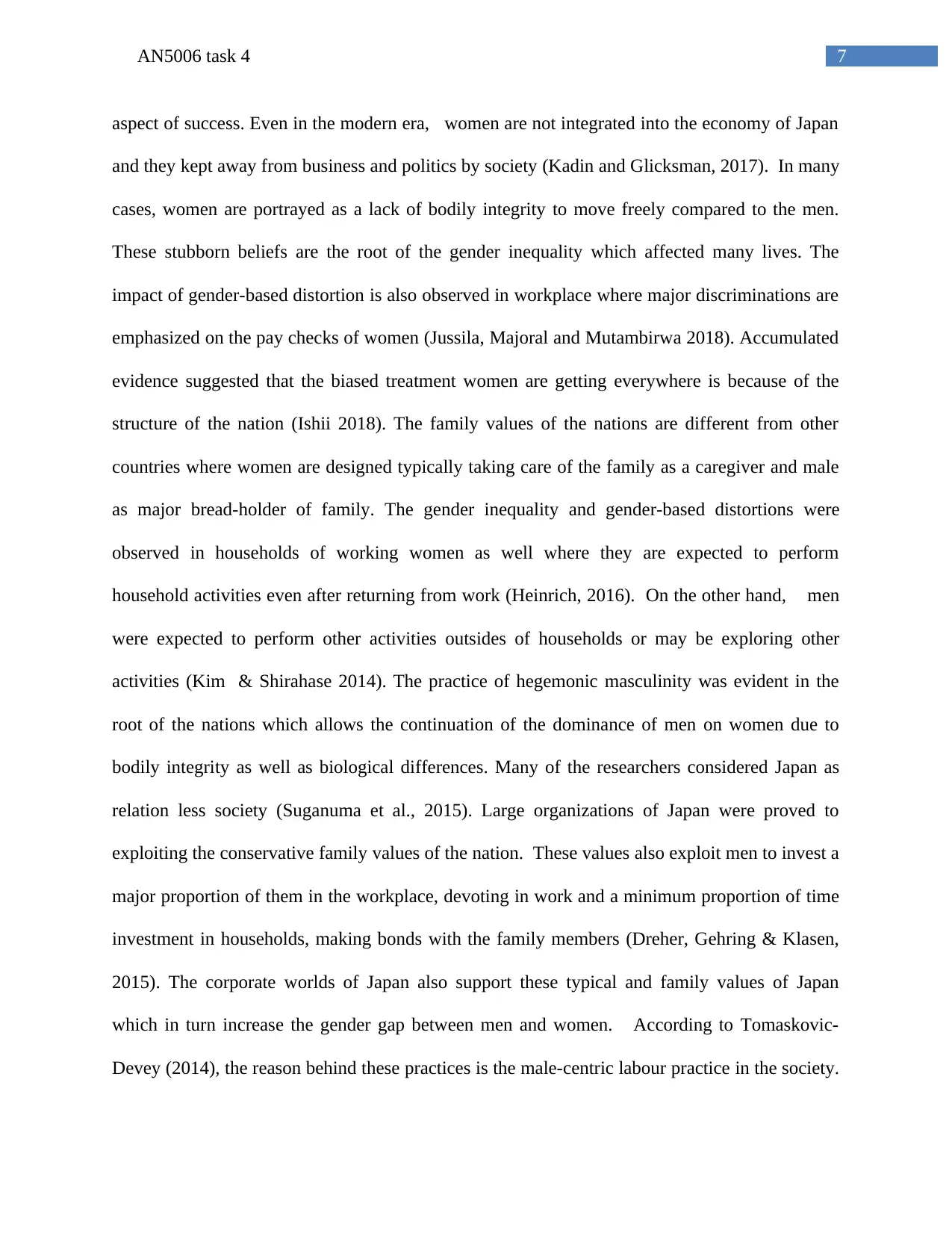
7AN5006 task 4
aspect of success. Even in the modern era, women are not integrated into the economy of Japan
and they kept away from business and politics by society (Kadin and Glicksman, 2017). In many
cases, women are portrayed as a lack of bodily integrity to move freely compared to the men.
These stubborn beliefs are the root of the gender inequality which affected many lives. The
impact of gender-based distortion is also observed in workplace where major discriminations are
emphasized on the pay checks of women (Jussila, Majoral and Mutambirwa 2018). Accumulated
evidence suggested that the biased treatment women are getting everywhere is because of the
structure of the nation (Ishii 2018). The family values of the nations are different from other
countries where women are designed typically taking care of the family as a caregiver and male
as major bread-holder of family. The gender inequality and gender-based distortions were
observed in households of working women as well where they are expected to perform
household activities even after returning from work (Heinrich, 2016). On the other hand, men
were expected to perform other activities outsides of households or may be exploring other
activities (Kim & Shirahase 2014). The practice of hegemonic masculinity was evident in the
root of the nations which allows the continuation of the dominance of men on women due to
bodily integrity as well as biological differences. Many of the researchers considered Japan as
relation less society (Suganuma et al., 2015). Large organizations of Japan were proved to
exploiting the conservative family values of the nation. These values also exploit men to invest a
major proportion of them in the workplace, devoting in work and a minimum proportion of time
investment in households, making bonds with the family members (Dreher, Gehring & Klasen,
2015). The corporate worlds of Japan also support these typical and family values of Japan
which in turn increase the gender gap between men and women. According to Tomaskovic-
Devey (2014), the reason behind these practices is the male-centric labour practice in the society.
aspect of success. Even in the modern era, women are not integrated into the economy of Japan
and they kept away from business and politics by society (Kadin and Glicksman, 2017). In many
cases, women are portrayed as a lack of bodily integrity to move freely compared to the men.
These stubborn beliefs are the root of the gender inequality which affected many lives. The
impact of gender-based distortion is also observed in workplace where major discriminations are
emphasized on the pay checks of women (Jussila, Majoral and Mutambirwa 2018). Accumulated
evidence suggested that the biased treatment women are getting everywhere is because of the
structure of the nation (Ishii 2018). The family values of the nations are different from other
countries where women are designed typically taking care of the family as a caregiver and male
as major bread-holder of family. The gender inequality and gender-based distortions were
observed in households of working women as well where they are expected to perform
household activities even after returning from work (Heinrich, 2016). On the other hand, men
were expected to perform other activities outsides of households or may be exploring other
activities (Kim & Shirahase 2014). The practice of hegemonic masculinity was evident in the
root of the nations which allows the continuation of the dominance of men on women due to
bodily integrity as well as biological differences. Many of the researchers considered Japan as
relation less society (Suganuma et al., 2015). Large organizations of Japan were proved to
exploiting the conservative family values of the nation. These values also exploit men to invest a
major proportion of them in the workplace, devoting in work and a minimum proportion of time
investment in households, making bonds with the family members (Dreher, Gehring & Klasen,
2015). The corporate worlds of Japan also support these typical and family values of Japan
which in turn increase the gender gap between men and women. According to Tomaskovic-
Devey (2014), the reason behind these practices is the male-centric labour practice in the society.
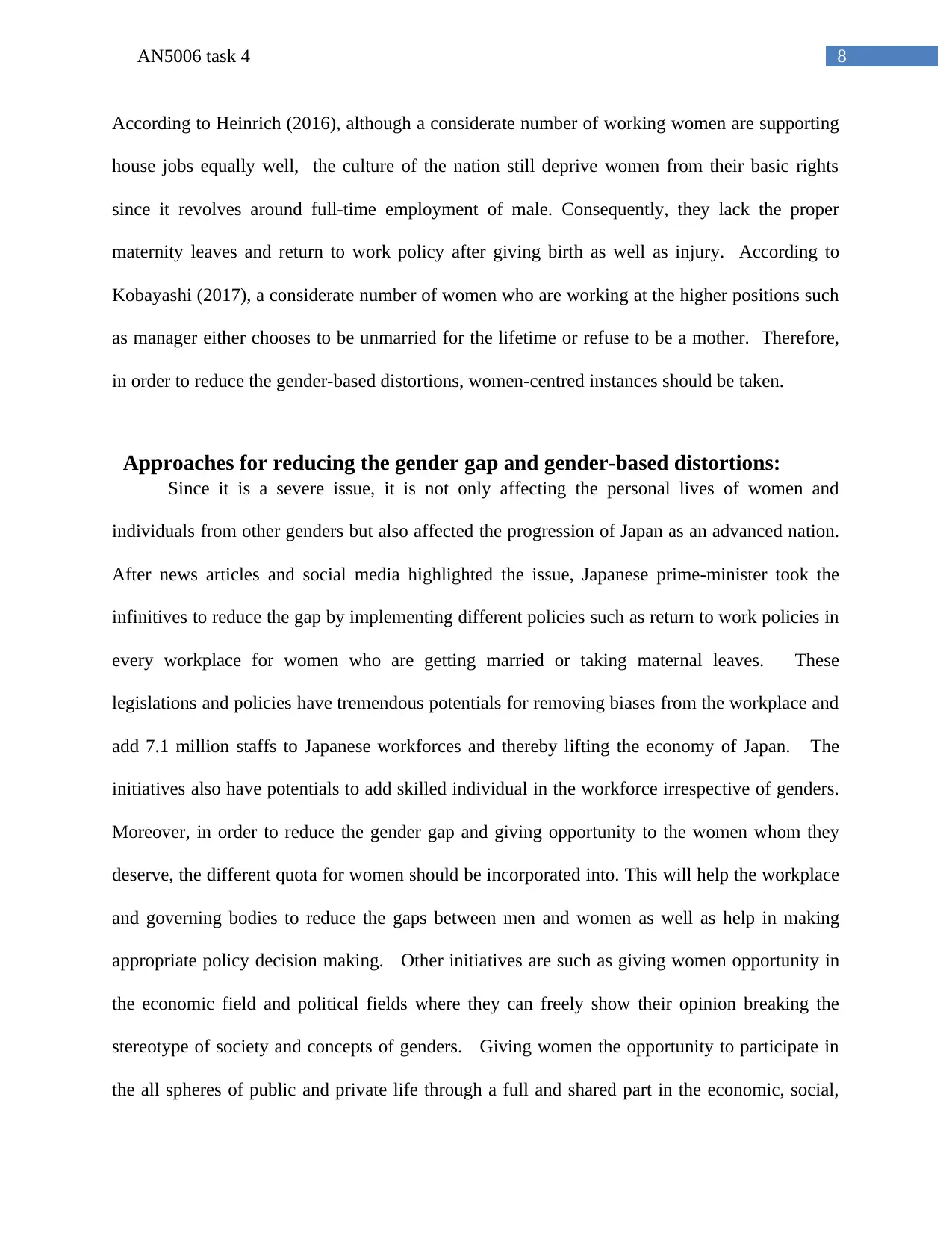
8AN5006 task 4
According to Heinrich (2016), although a considerate number of working women are supporting
house jobs equally well, the culture of the nation still deprive women from their basic rights
since it revolves around full-time employment of male. Consequently, they lack the proper
maternity leaves and return to work policy after giving birth as well as injury. According to
Kobayashi (2017), a considerate number of women who are working at the higher positions such
as manager either chooses to be unmarried for the lifetime or refuse to be a mother. Therefore,
in order to reduce the gender-based distortions, women-centred instances should be taken.
Approaches for reducing the gender gap and gender-based distortions:
Since it is a severe issue, it is not only affecting the personal lives of women and
individuals from other genders but also affected the progression of Japan as an advanced nation.
After news articles and social media highlighted the issue, Japanese prime-minister took the
infinitives to reduce the gap by implementing different policies such as return to work policies in
every workplace for women who are getting married or taking maternal leaves. These
legislations and policies have tremendous potentials for removing biases from the workplace and
add 7.1 million staffs to Japanese workforces and thereby lifting the economy of Japan. The
initiatives also have potentials to add skilled individual in the workforce irrespective of genders.
Moreover, in order to reduce the gender gap and giving opportunity to the women whom they
deserve, the different quota for women should be incorporated into. This will help the workplace
and governing bodies to reduce the gaps between men and women as well as help in making
appropriate policy decision making. Other initiatives are such as giving women opportunity in
the economic field and political fields where they can freely show their opinion breaking the
stereotype of society and concepts of genders. Giving women the opportunity to participate in
the all spheres of public and private life through a full and shared part in the economic, social,
According to Heinrich (2016), although a considerate number of working women are supporting
house jobs equally well, the culture of the nation still deprive women from their basic rights
since it revolves around full-time employment of male. Consequently, they lack the proper
maternity leaves and return to work policy after giving birth as well as injury. According to
Kobayashi (2017), a considerate number of women who are working at the higher positions such
as manager either chooses to be unmarried for the lifetime or refuse to be a mother. Therefore,
in order to reduce the gender-based distortions, women-centred instances should be taken.
Approaches for reducing the gender gap and gender-based distortions:
Since it is a severe issue, it is not only affecting the personal lives of women and
individuals from other genders but also affected the progression of Japan as an advanced nation.
After news articles and social media highlighted the issue, Japanese prime-minister took the
infinitives to reduce the gap by implementing different policies such as return to work policies in
every workplace for women who are getting married or taking maternal leaves. These
legislations and policies have tremendous potentials for removing biases from the workplace and
add 7.1 million staffs to Japanese workforces and thereby lifting the economy of Japan. The
initiatives also have potentials to add skilled individual in the workforce irrespective of genders.
Moreover, in order to reduce the gender gap and giving opportunity to the women whom they
deserve, the different quota for women should be incorporated into. This will help the workplace
and governing bodies to reduce the gaps between men and women as well as help in making
appropriate policy decision making. Other initiatives are such as giving women opportunity in
the economic field and political fields where they can freely show their opinion breaking the
stereotype of society and concepts of genders. Giving women the opportunity to participate in
the all spheres of public and private life through a full and shared part in the economic, social,
⊘ This is a preview!⊘
Do you want full access?
Subscribe today to unlock all pages.

Trusted by 1+ million students worldwide
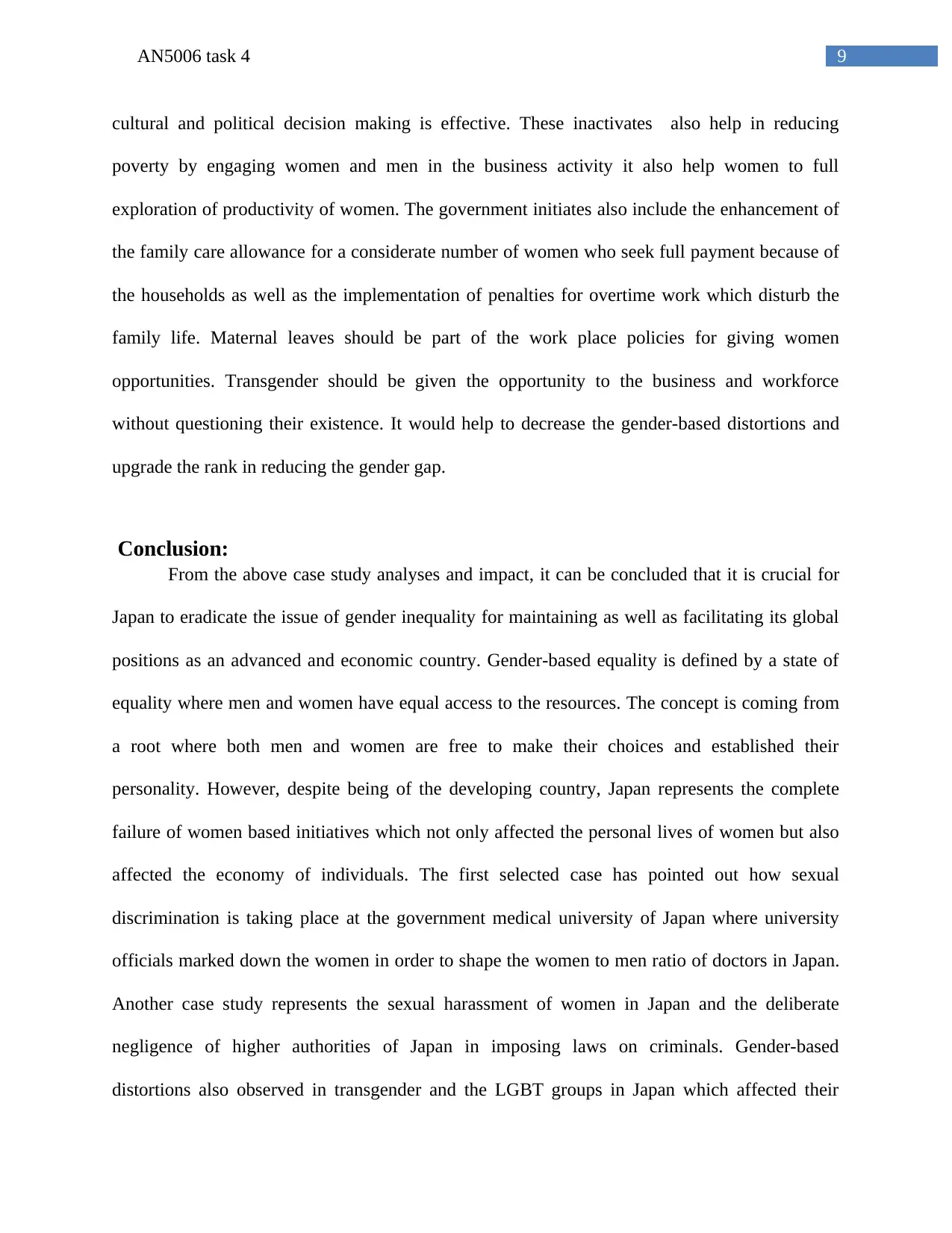
9AN5006 task 4
cultural and political decision making is effective. These inactivates also help in reducing
poverty by engaging women and men in the business activity it also help women to full
exploration of productivity of women. The government initiates also include the enhancement of
the family care allowance for a considerate number of women who seek full payment because of
the households as well as the implementation of penalties for overtime work which disturb the
family life. Maternal leaves should be part of the work place policies for giving women
opportunities. Transgender should be given the opportunity to the business and workforce
without questioning their existence. It would help to decrease the gender-based distortions and
upgrade the rank in reducing the gender gap.
Conclusion:
From the above case study analyses and impact, it can be concluded that it is crucial for
Japan to eradicate the issue of gender inequality for maintaining as well as facilitating its global
positions as an advanced and economic country. Gender-based equality is defined by a state of
equality where men and women have equal access to the resources. The concept is coming from
a root where both men and women are free to make their choices and established their
personality. However, despite being of the developing country, Japan represents the complete
failure of women based initiatives which not only affected the personal lives of women but also
affected the economy of individuals. The first selected case has pointed out how sexual
discrimination is taking place at the government medical university of Japan where university
officials marked down the women in order to shape the women to men ratio of doctors in Japan.
Another case study represents the sexual harassment of women in Japan and the deliberate
negligence of higher authorities of Japan in imposing laws on criminals. Gender-based
distortions also observed in transgender and the LGBT groups in Japan which affected their
cultural and political decision making is effective. These inactivates also help in reducing
poverty by engaging women and men in the business activity it also help women to full
exploration of productivity of women. The government initiates also include the enhancement of
the family care allowance for a considerate number of women who seek full payment because of
the households as well as the implementation of penalties for overtime work which disturb the
family life. Maternal leaves should be part of the work place policies for giving women
opportunities. Transgender should be given the opportunity to the business and workforce
without questioning their existence. It would help to decrease the gender-based distortions and
upgrade the rank in reducing the gender gap.
Conclusion:
From the above case study analyses and impact, it can be concluded that it is crucial for
Japan to eradicate the issue of gender inequality for maintaining as well as facilitating its global
positions as an advanced and economic country. Gender-based equality is defined by a state of
equality where men and women have equal access to the resources. The concept is coming from
a root where both men and women are free to make their choices and established their
personality. However, despite being of the developing country, Japan represents the complete
failure of women based initiatives which not only affected the personal lives of women but also
affected the economy of individuals. The first selected case has pointed out how sexual
discrimination is taking place at the government medical university of Japan where university
officials marked down the women in order to shape the women to men ratio of doctors in Japan.
Another case study represents the sexual harassment of women in Japan and the deliberate
negligence of higher authorities of Japan in imposing laws on criminals. Gender-based
distortions also observed in transgender and the LGBT groups in Japan which affected their
Paraphrase This Document
Need a fresh take? Get an instant paraphrase of this document with our AI Paraphraser
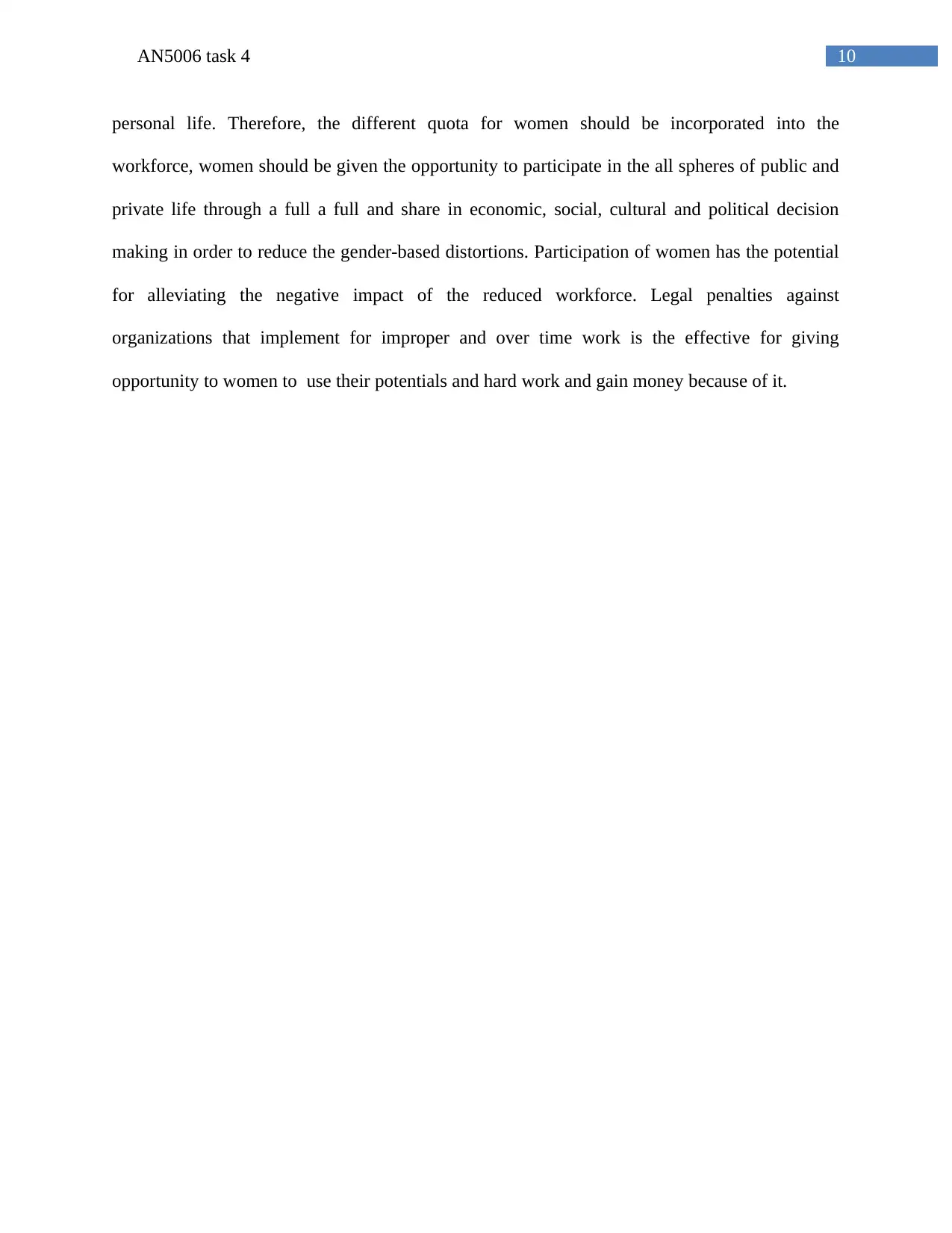
10AN5006 task 4
personal life. Therefore, the different quota for women should be incorporated into the
workforce, women should be given the opportunity to participate in the all spheres of public and
private life through a full a full and share in economic, social, cultural and political decision
making in order to reduce the gender-based distortions. Participation of women has the potential
for alleviating the negative impact of the reduced workforce. Legal penalties against
organizations that implement for improper and over time work is the effective for giving
opportunity to women to use their potentials and hard work and gain money because of it.
personal life. Therefore, the different quota for women should be incorporated into the
workforce, women should be given the opportunity to participate in the all spheres of public and
private life through a full a full and share in economic, social, cultural and political decision
making in order to reduce the gender-based distortions. Participation of women has the potential
for alleviating the negative impact of the reduced workforce. Legal penalties against
organizations that implement for improper and over time work is the effective for giving
opportunity to women to use their potentials and hard work and gain money because of it.
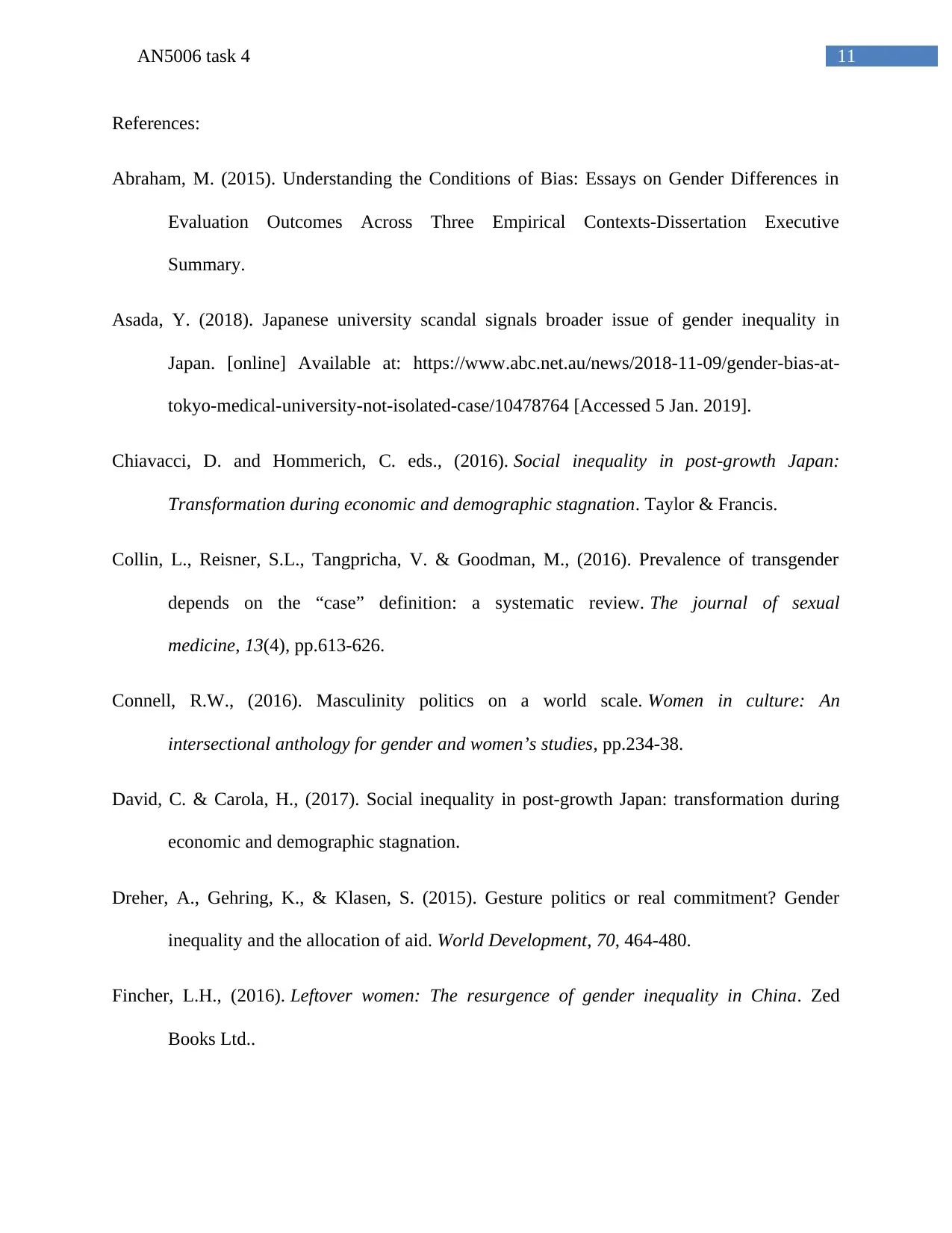
11AN5006 task 4
References:
Abraham, M. (2015). Understanding the Conditions of Bias: Essays on Gender Differences in
Evaluation Outcomes Across Three Empirical Contexts-Dissertation Executive
Summary.
Asada, Y. (2018). Japanese university scandal signals broader issue of gender inequality in
Japan. [online] Available at: https://www.abc.net.au/news/2018-11-09/gender-bias-at-
tokyo-medical-university-not-isolated-case/10478764 [Accessed 5 Jan. 2019].
Chiavacci, D. and Hommerich, C. eds., (2016). Social inequality in post-growth Japan:
Transformation during economic and demographic stagnation. Taylor & Francis.
Collin, L., Reisner, S.L., Tangpricha, V. & Goodman, M., (2016). Prevalence of transgender
depends on the “case” definition: a systematic review. The journal of sexual
medicine, 13(4), pp.613-626.
Connell, R.W., (2016). Masculinity politics on a world scale. Women in culture: An
intersectional anthology for gender and women’s studies, pp.234-38.
David, C. & Carola, H., (2017). Social inequality in post-growth Japan: transformation during
economic and demographic stagnation.
Dreher, A., Gehring, K., & Klasen, S. (2015). Gesture politics or real commitment? Gender
inequality and the allocation of aid. World Development, 70, 464-480.
Fincher, L.H., (2016). Leftover women: The resurgence of gender inequality in China. Zed
Books Ltd..
References:
Abraham, M. (2015). Understanding the Conditions of Bias: Essays on Gender Differences in
Evaluation Outcomes Across Three Empirical Contexts-Dissertation Executive
Summary.
Asada, Y. (2018). Japanese university scandal signals broader issue of gender inequality in
Japan. [online] Available at: https://www.abc.net.au/news/2018-11-09/gender-bias-at-
tokyo-medical-university-not-isolated-case/10478764 [Accessed 5 Jan. 2019].
Chiavacci, D. and Hommerich, C. eds., (2016). Social inequality in post-growth Japan:
Transformation during economic and demographic stagnation. Taylor & Francis.
Collin, L., Reisner, S.L., Tangpricha, V. & Goodman, M., (2016). Prevalence of transgender
depends on the “case” definition: a systematic review. The journal of sexual
medicine, 13(4), pp.613-626.
Connell, R.W., (2016). Masculinity politics on a world scale. Women in culture: An
intersectional anthology for gender and women’s studies, pp.234-38.
David, C. & Carola, H., (2017). Social inequality in post-growth Japan: transformation during
economic and demographic stagnation.
Dreher, A., Gehring, K., & Klasen, S. (2015). Gesture politics or real commitment? Gender
inequality and the allocation of aid. World Development, 70, 464-480.
Fincher, L.H., (2016). Leftover women: The resurgence of gender inequality in China. Zed
Books Ltd..
⊘ This is a preview!⊘
Do you want full access?
Subscribe today to unlock all pages.

Trusted by 1+ million students worldwide
1 out of 14
Related Documents
Your All-in-One AI-Powered Toolkit for Academic Success.
+13062052269
info@desklib.com
Available 24*7 on WhatsApp / Email
![[object Object]](/_next/static/media/star-bottom.7253800d.svg)
Unlock your academic potential
Copyright © 2020–2025 A2Z Services. All Rights Reserved. Developed and managed by ZUCOL.





